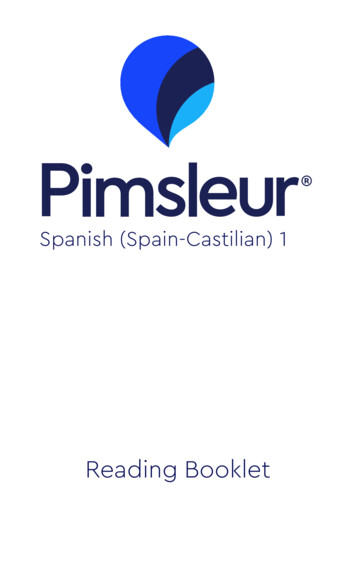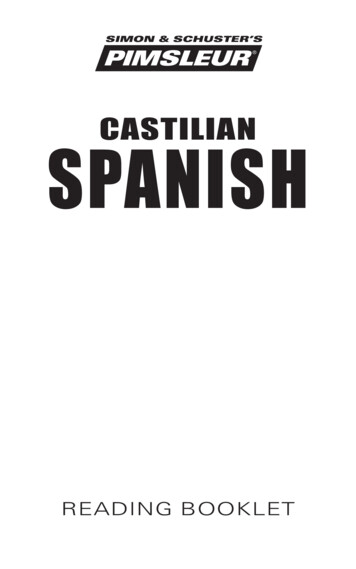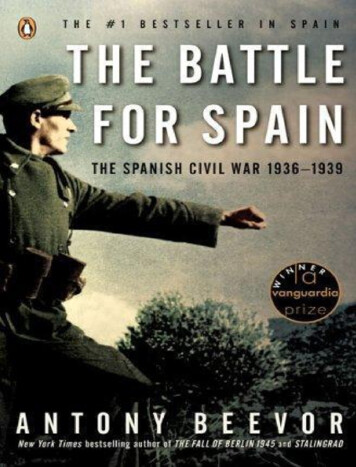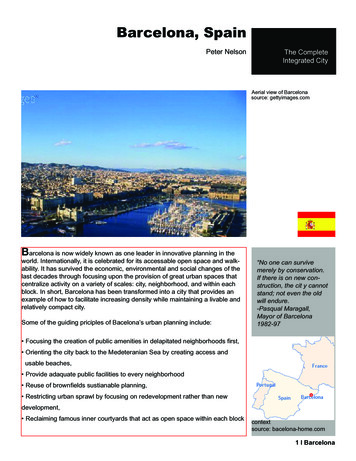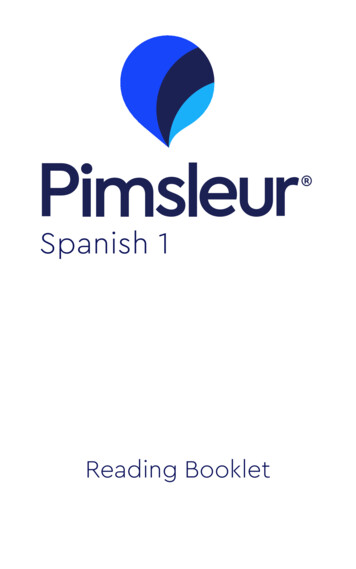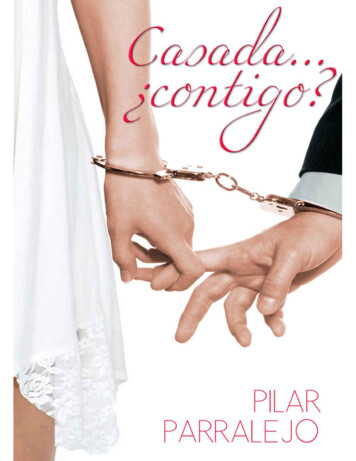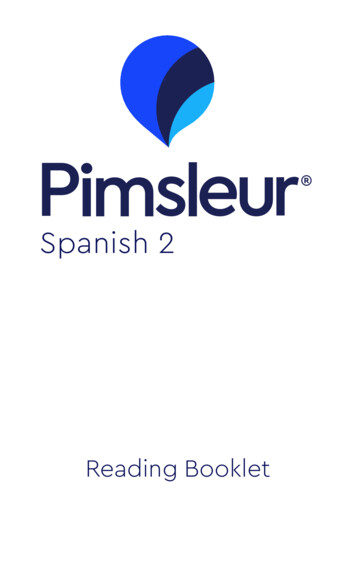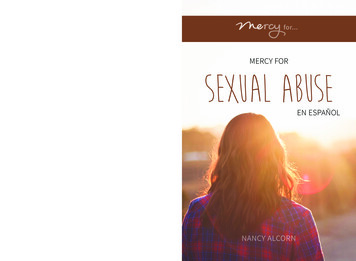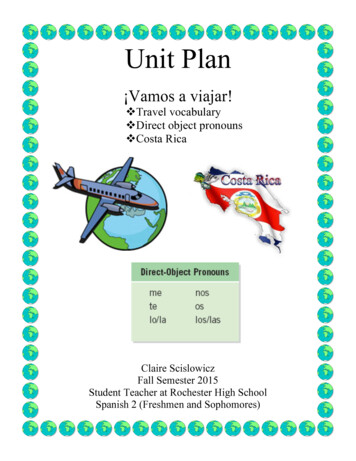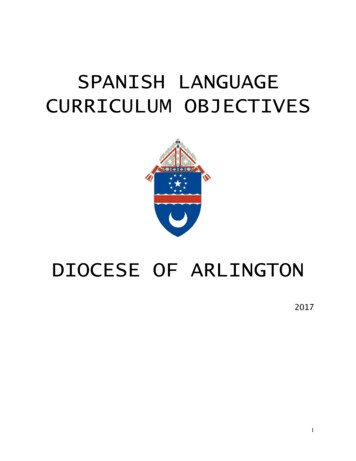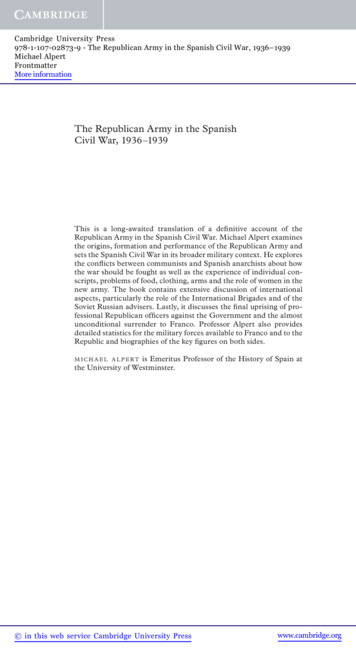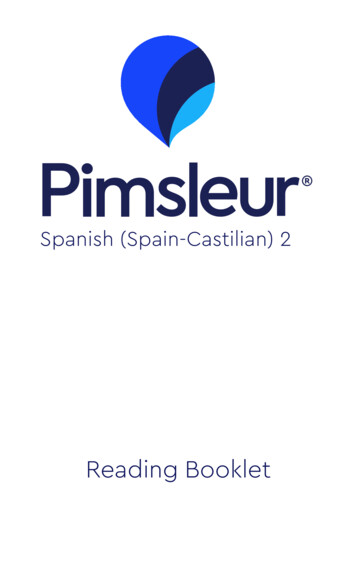
Transcription
Spanish (Spain-Castilian) 2Reading Booklet
Spanish (Spain-Castilian) 2Travelers should always check withtheir nation's State Department forcurrent advisories on local conditionsbefore traveling abroad.Booklet Design: Maia Kennedy and ‰ Recorded Program 2018 Simon & Schuster, Inc. Reading Booklet 2018 Simon & Schuster, Inc.Pimsleur is an imprint of Simon & Schuster Audio,a division of Simon & Schuster, Inc. Mfg. in USA.All rights reserved.ii
Spanish (Spain-Castilian) 2ACKNOWLEDGMENTSVoicesEnglish-Speaking Instructor . . . . . . . . . . . . . . Ray BrownSpanish-Speaking Instructor . . Gerard Otalora CanovasFemale Spanish Speaker . . . . . . . . . . Inés Román DáneoMale Spanish Speaker . . . . . . . . . . . . . . . Julio LumbrerasCourse WritersJaime Mauricio Fatás Cabeza Joan SchoellnerEditorsLisbet Beryl Weir Beverly D. HeinleReviewerMaría Del Carmen Nicolás AlbaProducer & DirectorSarah H. McInnisRecording EngineerPeter S. TurpinSimon & Schuster Studios, Concord, MAiii
Spanish (Spain-Castilian) 2Table of ContentsIntroductionThe Spanish Language . . . . . . . . . . . . . . . . . . .Spanish "you" . . . . . . . . . . . . . . . . . . . . . . . . . .The Reading Lessons . . . . . . . . . . . . . . . . . . . .113Lección uno . . . . . . . . . . . . . . . . . . . . . . . . . . . . . .Lección dos . . . . . . . . . . . . . . . . . . . . . . . . . . . . . .Lección tres . . . . . . . . . . . . . . . . . . . . . . . . . . . . . .Lección cuatro . . . . . . . . . . . . . . . . . . . . . . . . . . . .Lección cinco . . . . . . . . . . . . . . . . . . . . . . . . . . . . .Lección seis . . . . . . . . . . . . . . . . . . . . . . . . . . . . . .Lección siete . . . . . . . . . . . . . . . . . . . . . . . . . . . . .Lección ocho . . . . . . . . . . . . . . . . . . . . . . . . . . . . .Lección nueve . . . . . . . . . . . . . . . . . . . . . . . . . . . .Lección diez . . . . . . . . . . . . . . . . . . . . . . . . . . . . . .Lección once . . . . . . . . . . . . . . . . . . . . . . . . . . . . .Lección doce . . . . . . . . . . . . . . . . . . . . . . . . . . . . .Lección trece . . . . . . . . . . . . . . . . . . . . . . . . . . . . .Lección catorce . . . . . . . . . . . . . . . . . . . . . . . . . . .Lección quince . . . . . . . . . . . . . . . . . . . . . . . . . . . .Lección dieciséis . . . . . . . . . . . . . . . . . . . . . . . . . .Lección diecisiete . . . . . . . . . . . . . . . . . . . . . . . . .Lección dieciocho . . . . . . . . . . . . . . . . . . . . . . . . .Lección diecinueve . . . . . . . . . . . . . . . . . . . . . . . .Lección veinte . . . . . . . . . . . . . . . . . . . . . . . . . . . .5791113151719212325272931333638404244iv
Spanish (Spain-Castilian) 2The Spanish LanguagePimsleur’s Spanish (Spain-Castilian) 2 continuesto teach the official language of Spain as it is spokenby the majority of its population. A brief history of theSpanish language, a summary of the primary differences between Latin American Spanish and CastilianSpanish, and information about the Spanish alphabetcan be found in the Spanish (Spain-Castilian) Level 1Reading Booklet.Spanish “you”In English, you use the pronoun “you” when talkingto any person or group of people, and whetheryou are addressing someone formally or informally.However, in Spanish there are two sets of wordsthat mean “you:” one set for the informal “you” (the“familiar register”), which in Castilian Spanish is tú inthe singular and vosotros in the plural, and a secondset for the formal “you,” which is usted in the singular(often abbreviated as Ud.) and ustedes in the plural(often abbreviated as Uds.). The form to be useddepends on how well you know the people you’retalking to and the circumstances of the conversation.In Spanish (Spain-Castilian) 1, you primarily usedthe formal forms, which you will need in hotels andrestaurants and when addressing people whom youdon’t know. In Spanish (Spain-Castilian) 2, you will
Spanish (Spain-Castilian) 2learn and practice more informal forms, which you’lluse with friends, acquaintances, and co-workers. Thefollowing guidelines can be helpful to steer you in theright direction when deciding on which form to use.The singular informal tú and the plural informalvosotros are now used widely in Spain. (Vosotrosis not used in Latin America.) In general, they arethe standard forms of address for almost everyone,including co-workers, friends or close acquaintances,and children. They have become the norm, especiallyamong people of a similar social status or age. Ustedand ustedes are used when speaking with others incircumstances that require a degree of formality.However, in some rural regions usted is stillused even with family members, chiefly those fromprevious generations. Also, in business, academic,legal, and government settings, usted(es) is still usedfrequently and is often standard, especially whenolder people are involved. In those circumstances,it’s a good idea to address a new acquaintance asusted to be on the safe side, or when you want toestablish a certain distance.The use of formal registers has lost ground in thelast decades as a result of the liberalization of society,and informal forms of address are used in almost anysetting. In general, keep in mind that these rules are2
Spanish (Spain-Castilian) 2not set in stone and that there are exceptions. Theremight be situations where you run the risk of soundingarrogant or disrespectful if you use the informal “you”where the formal is required. So, if you are not surewhich one to use, it is usually better to err on the sideof politeness: Use usted or ustedes unless or until theSpanish speaker addresses you with tú, or asks youto use it, saying something like, "Por favor, tutéame"("Please, address me as tú"). In any event, it’s a goodpolicy to be observant and adaptable.The Reading LessonsSpanish (Spain-Castilian) 2 includes twentyReading Lessons. These lessons will provide readingpractice, and they will also expand your vocabulary.They include topics such as discussing vacationplans, asking for directions, talking about one’sfamily, scheduling a tennis match, dealing with asudden illness, planning an evening at a concert,and discussing a book.Lessons on numbers,times, and idiomatic expressions are also included.Translations are provided for each lesson, althoughwe recommend that you look at the translations onlyafter doing the lessons.The Reading Lessons are all recorded at the endof the program. You can do the Readings when you3
Spanish (Spain-Castilian) 2wish—either along with the lessons or at a moreconvenient time afterwards. Instructions on how todo the Readings are contained in the audio.4
Spanish (Spain-Castilian) 2Lección unoPlanes para un viaje1.La semana que viene .2.me voy de vacaciones.3.¿A dónde vas?4.A Córdoba y a Sevilla.5.Me han dicho .6.que son muy interesantes.7.Es verdad. ¿Cuánto tiempo .8.vas a quedarte?9.En Córdoba, solo un día.10.En Sevilla, tres días.11.Tres días en Sevilla es buena idea.12.Hay mucho que ver.13.¿Viajas solo?14.Sí, pero un amigo mío vive allí.15.Antes de irte, quizá .16.quizá podamos comer juntos.17.¿Tienes tiempo el viernes?18.Sí, el viernes está bien. ¿A qué hora?19.Todavía no lo sé.20.Te mandaré un mensaje.5
Spanish (Spain-Castilian) 2Lesson One TranslationsPlans for a Trip1.Next week .2.I’m leaving on vacation.3.To where are you going?4.To Cordoba and to Seville.5.They’ve told me .6.that they’re very interesting.7.It’s true. How long .8.are you going to stay?9.In Cordoba, only one day.10.In Seville, three days.11.Three days in Seville is a good idea.12.There’s a lot to see.13.Are you traveling alone?14.Yes, but a friend of mine lives there.15.Before you leave, maybe .16.maybe we can eat together.17.Do you have time on Friday?18.Yes, on Friday is fine. At what time?19.I don’t know yet.20.I’ll text you.6
Spanish (Spain-Castilian) 2Lección dosPreguntar dónde se encuentra1.El señor preguntó:2.¿Puede ayudarme?3.Busco el Café Baraka.4.Está en la calle Serrano.5.No puedo encontrar la calle .6.y mi móvil no funciona aquí.7.Pero tengo un mapa.8.¿Puede mostrarme en el mapa .9.dónde está?10.La mujer contestó:11.Por supuesto que sí.12.No necesita mapa.13.No está lejos.14.Está a solo tres manzanas de aquí.15.Siga recto .16.hasta la farmacia.17.Luego, tome la primera calle a la derecha.18.El café está a la izquierda.19.Muchas gracias, señora.20.De nada.7
Spanish (Spain-Castilian) 2Lesson Two TranslationsAsking for Directions1.The man asked:2.Can you help me?3.I’m looking for Café Baraka.4.It’s on Serrano Street.5.I can’t find the street 6.and my cell phone doesn’t work here.7.But I have a map.8.Can you show me in the map 9.where it is?10.The woman answered:11.Of course.12.You don’t need a map.13.It’s not far.14.It’s only three blocks from here.15.Continue straight ahead 16.until the pharmacy.17.Then, take the first street on the right.18.The café is on the left.19.Thank you very much, ma’am.20.You’re welcome.8
Spanish (Spain-Castilian) 2Lección tresUn día de lluvia en San Sebastián1.¿Qué tiempo hace en San Sebastián?2.Hoy hace calor y sol.3.Pero mañana va a hacer más fresco .4.y es posible que llueva.5.Así que deberías traer un paraguas .6.o un impermeable.7.¿Qué deberíamos hacer si llueve?8.No podemos ir a la playa.9.Podríamos ir al acuario.10.Es muy famoso.11.Además, está cerca de la Parte Vieja .12.así que podemos comer allí.13.O, si prefieres, .14.podemos ir a un museo.15.Quizá al Museo San Telmo, .16.sobre la cultura vasca.17.La Tabakalera es también muy interesante.18.Si hace mal tiempo .19.vamos al acuario.20.De acuerdo. Te veo mañana.9
Spanish (Spain-Castilian) 2Lesson Three TranslationsA Rainy Day in San Sebastian1.How’s the weather in San Sebastian?2.Today it’s hot and sunny.3.But tomorrow it’s going to be colder 4.and it might rain.5.So you should bring an umbrella 6.or a raincoat.7.What should we do if it rains?8.We can’t go to the beach.9.We could go to the aquarium.10.It’s very well-known.11.In addition, it’s near the Old Quarter .12.so we can eat there.13.Or, if you prefer, .14.we can go to a museum.15.Maybe to the San Telmo Museum, 16.about the Basque culture.17.La Tabakalera is also very interesting.18.If it’s bad weather 19.let’s go to the aquarium.20.Agreed. I’ll see you tomorrow.10
Spanish (Spain-Castilian) 2Lección cuatroPlanes para la tarde1.Mañana por la tarde .2.¿quieres venir al cine conmigo?3.Ponen la nueva película de Almodóvar .4.en el Cine Callao.5.Me gustaría verla .6.pero no puedo ir mañana.7.Mañana voy a visitar a una amiga mía.8.Es italiana, y es muy simpática.9.Escribe libros para niños.10.Deberías conocerla.11.Quizá el sábado podamos cenar juntos.12.Vale. ¿Dónde quieres cenar?13.¿Conoces La Barraca?14.Sí, estuve allí hace dos semanas.15.Me gustó mucho.16.Y antes de cenar, tú y yo .17.¿quizá podamos ir al cine?18.Creo que la película comienza .19.a las seis y media.20.De acuerdo. Hasta el sábado.11
Spanish (Spain-Castilian) 2Lesson Four TranslationsPlans for the 8.19.20.Tomorrow evening do you want to come to the movies with me?They’re showing the new movieby Almodovar in the Callao Theater.I’d like to see it but I can’t go tomorrow.Tomorrow I’m going to visit a friend of mine.She’s Italian, and she’s very nice.She writes books for children.You should meet her.Maybe on Saturday we can havedinner together.OK. Where do you want to have dinner?Do you know La Barraca?Yes, I was there two weeks ago.I liked it very much.And before having dinner, you and I maybe we can go to the movies?I believe that the movie starts at six-thirty.Agreed. Until Saturday.12
Spanish (Spain-Castilian) 2Lección cincoUna conversación en un restaurante1.¿Qué quieres comer?2.Voy a pedir una tortilla de patatas .3.y un vino blanco. ¿Y tú?4.Me gusta mucho la paella .5.pero es demasiado para una persona.6.Voy a pedir un filete.7.Y una cerveza. Tengo sed.8.Por cierto, .9.¿qué tal la reunión ayer?10.Estuvo muy bien. Muy interesante.11.Y tú, ¿qué hiciste ayer?12.Estuve en el Prado.13.Me gustan mucho los cuadros de Velázquez.14.Dime – ¿ves a ese señor allí?15.Es un compañero de trabajo.16.Es americano, de San Francisco.17.¡No me digas! Yo soy de San Francisco.18.Se llama Lucas Wilson. ¿Lo conoces?19.No, no lo conozco.20.Es muy simpático; voy a presentártelo.13
Spanish (Spain-Castilian) 2Lesson Five TranslationsA Conversation in a 7.18.19.20.What do you want to eat?I’m going to order a Spanish omelette and a (glass of) white wine. And you?I like paella a lot .but it’s too much for one person.I‘m going to order a steak.And a beer. I’m thirsty.By the way, how was the meeting yesterday?It was very good. Very interesting.And you, what did you do yesterday?I was in the Prado.I like Velazquez’s paintings very much.Tell me – do you see that gentlemanover there?He’s a co-worker.He’s American, from San Francisco.You don’t say! I’m from San Francisco.His name is Lucas Wilson. Do you know him?No, I don’t know him.He’s very nice; I’m going to introduce himto you.14
Spanish (Spain-Castilian) 2Lección seisUn mensaje de 19.20.Mensaje para Roberto Duarte:¡Perdona! No he podido contestarte antes.Ahora estoy en Barcelona.Es una ciudad muy interesante, .pero he tenido demasiado trabajo.Me voy a Madrid el lunes.Me quedo en el Hotel Plaza Mayor.¿Podemos encontrarnos en algún lugar?Quizá el martes a la una, para comer.Tenemos que hablar de variascosas importantes.Contéstame cuanto antes.Prometo contestar el mismo día.Y ¿cómo va ese gran proyecto?¿Hay algo nuevo?Después de Madrid, me voy a la Costadel Sol .para tres, cuatro días.Me han dicho que es muy bonita.Además, necesito unas vacaciones.Saludos a tu mujer.Hasta pronto. --- Daniel.15
Spanish (Spain-Castilian) 2Lesson Six Transl
Pimsleur’s Spanish (Spain-Castilian) 2 continues to teach the official language of Spain as it is spoken by the majority of its population. A brief history of the Spanish language, a summary of the primary differ-ences between Latin American Spanish and Castilian Spanish, and information about the Spanish alphabet can be found in the Spanish (Spain-Castilian) Level 1 Reading Booklet. Spanish .
